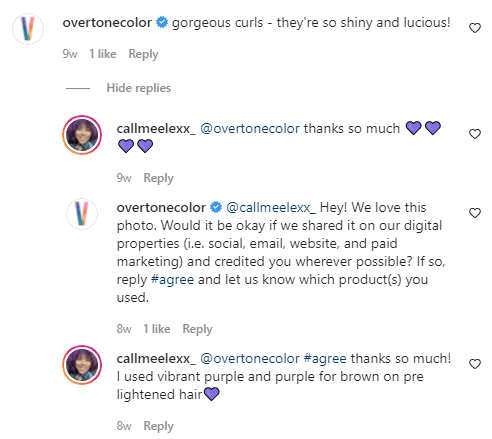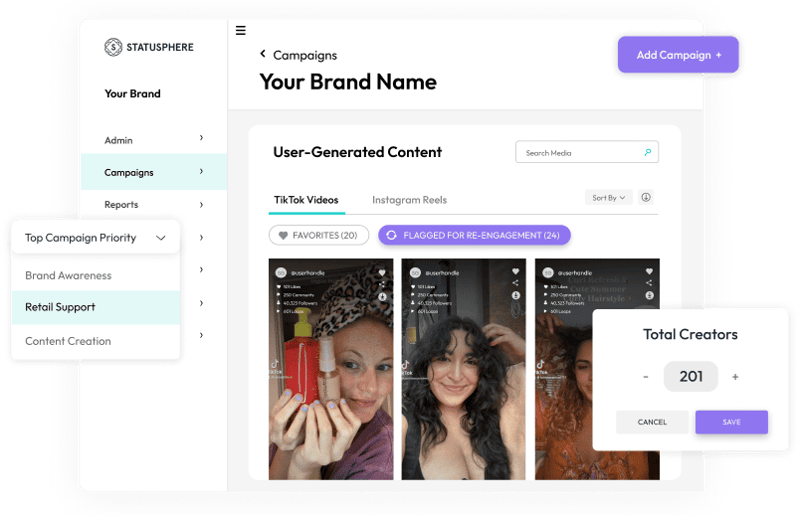How to Send PR Packages to Influencers Step-By-Step
Sending PR packages to influencers is a brilliant way to build awareness and earn repurposable content. This post breaks down how to ship products to...
Ready to repurpose UGC that your brand owns? Learn best practices for repurposing user-generated content and influencer posts to maximize their marketing impact.


How often is your brand repurposing user-generated content?
If the answer's not "all the time," things need to change!
After all, authentic UGC is among your most impactful marketing assets.
We're seeing more and more brands repurposing user-generated content in paid campaigns to great results. Look no further than the boom of UGC ads as evidence.
Unfortunately, many brands fail to maximize the mileage out of their UGC.
The good news? You don't have to treat your user-generated content as “one and done."
With a UGC repurposing strategy, you can drive ongoing engagement and create high-performing ad campaigns with less legwork. Below are our best practices for repurposing user-generated and influencer-generated content.
Skip to Section 👇Why Brands Should Repurpose UGC and Influencer-Generated Content |
Let's assume you're already sitting on your fair share of organic UGC and influencer content.
Congrats! But are you maximizing those pieces of content to its full potential?
Brands with even a modest amount of UGC on hand should make repurposing a priority to:
For example, we have seen firsthand how more brands are repurposing influencer content into social ads. Specifically on TikTok, brands requesting Spark Ad Codes from creators to boost ad performance and run always-on campaigns.
Repurposing UGC isn't as simple as republishing a post and claiming it as your own.
Not by a long shot!
But before you start repurposing, it’s important to understand a few best practices.
The tips below will help you stay organized and ensure that your content gets the reach it deserves. Not to mention stay out of potential trouble when it comes to content rights management.
First thing’s first: a bit of housekeeping will help you avoid copyright infringement and other legal issues.
Just because someone tags you in a photo doesn’t mean that it’s fair game for promotion. Although rules and regulations around user-generated content promotions vary from platform to platform, here are some quick guidelines:
For example, check out how oVertone asks for permission to republish UGC via Instagram comments.

Source: @overtonecolor
In the case of repurposing influencer-generated content specifically, you can avoid a ton of headaches simply by having content rights management built into your influencer agreement.
This is also something to consider if you're using an influencer marketing platform to source your content. For example, Statusphere has branded content rights built into our platform.
That means our brands can quickly scale their content repurposing efforts via ads or organic posts without having to ask permission post-by-post.
If your brand gets consistent social engagement via product tagging and #hashtag campaigns, that's awesome news. This also means you’ve earned the right to be picky when repurposing UGC.
Because you shouldn’t promote any and every piece of content that comes your way.
Let's be real: not every piece of content is going to be a top contender to run as an ad.
Most brands that do influencer whitelisting on TikTok or Instagram reserve their ads for the best of the best when it comes to content. Rightfully so! Ideally, you should prioritize high-quality UGC that…
For example, Youth to the People republishes user-generated content of all shapes and sizes. From product close-ups to lifestyle shots and selfies, their feed features a bit of everything.
The brand repurposes content from influencers and creators with follower counts anywhere between 100 and 100,000+. Note how their engagement rate varies but is still relatively high.

Source: @youthtothepeople
Their content works regardless of follower count because their photos reflect their target audience.
The takeaway? Save your best UGC and influencer for repurposing and experiment from there. The definition of "best" is totally up to you.
Don’t feel pressured to promote content that your audience wouldn’t actually engage with organically. This also speaks to the value of having a high volume of content from micro-influencers versus only having a select handful of influencer posts to repurpose.
When repurposing UGC, be prepared to make some slight changes and edits prior to publishing.
Just because a piece of content works on Instagram doesn’t mean it’ll work on TikTok. The flip side is also true. Likewise, a massive customer photo likely needs to be cropped for use in a marketing email.
Meanwhile, every social network is different in terms of its “ideal” image sizes and requirements.
We’ve also seen instances of platforms discouraging direct cross-posting (like Instagram claiming their algorithm won’t favor cross-posted TikToks on Reels). For starters:
Below is an example of repurposed content between creators on TikTok and a brand on Instagram. Check out how Peach & Lily took a popular piece of UGC and transformed it into a Reel.

Source(s): @jordyn_wood / @peachandlily
Repurposing content for social media doesn’t have to be an intensive, time-consuming process. Some platforms make it much easier than others. For example, there are multiple ways to download a TikTok video (including without a watermark) that you can republish and repurpose elsewhere.
If you want to integrate UGC into your sales funnel, you need to keep track of it.
Organization matters!
Gathering your UGC solely via @mentions and #hashtags is a time-sink. Also, accounts can move and content can easily get lost or deleted over time. Oh, and you need to get the “thumbs up” from your creators to ensure you can use their content throughout your marketing campaigns.
That's why it's crucial to get ownership of your UGC and influencer content as soon as it's posted.
There are dedicated platforms out there that can find and aggregate UGC. But even with these tools, sourcing, saving and gathering permission yourself can feel like a full-time job.
That’s why we recommend working with a scalable micro-influencer platform (like Statusphere!) to generate high-quality, rights-ready UGC that requires no legwork on your part.
Our platform sources your creator content and obtains content rights at the same time. Through our campaign reporting and performance analytics, you can see which pieces of content are ideal for repurposing elsewhere.
The beauty of UGC campaigns is that they’re perfect for encouraging even more customer content in the future.
That’s why we always recommend scaling your influencer marketing campaigns versus treating them as one-offs. To keep your momentum going and ensure that customers keep hyping you up via content, make a point to:
As a result, you'll have an ongoing stream of content coming in organically and via influencers. That's the power of always-on influencer marketing in action.
Let's assume you're already encouraging UGC from your customers and creators. Nice!
To wrap things up, let’s brainstorm some UGC campaign ideas you can roll out yourself.
Arguably the easiest way to repurpose content for social media, some channels are easier to cross-post on than others. For example, we often see:
Brands like Black Milk do a brilliant job of cross-posting and repurposing UGC. By making slight changes to their posts’ captions and timing, they’re able to get more mileage out of their content.

Source: @blackmilkclothing
This strategy is a no-brainer for brands looking to repurpose influencer marketing content.
Just remember that each social platform has its own best practices when it comes to captions and hashtags. Small tweaks to your captions can make a difference to your audience, proving that you aren't just copying and pasting your content across social media.
If you're trying figure out how to repurpose influencer content in social ads, you're on the right track!
Creating ads out of owned UGC gives you greater creative freedom, not to mention flexibility with your budget and how long you run your campaigns.
Besides, UGC represents a prime opportunity to make your social ads not feel like ads at all. In turn, this has a positive impact on conversions and engagement. This applies to both TikTok and Instagram.
For example, check out what Instagram noted regarding the performance of Partnership ads featuring creators for Weekday:
Ads from creators typically outperform regular ads on Facebook and Instagram because they feel more informative, relevant and entertaining.
Again, it's crucial that you have content usage rights for the UGC you repurpose into ads. Asking for explicit permission from creators is ideal for UGC ads simply for the sake of transparency.
Both Instagram and TikTok also have platform-specific features that allow you to turn creator posts into sponsored content directly. Below is an example of those permissions via TikTok Spark Ads

(Check out our full post on how to make influencer content into ads for a deeper dive!)
Just like you can repurpose UGC for ads, the same rules apply to your marketing emails.
Below is an awesome example from Vieve that features a .gif of photos sourced from customers and creators on Instagram. The email breaks down which specific Vieve products each person used to achieve their look.
 Source: Milled
Source: Milled
Smart, right?
This strategy not only grabs the attention of your subscribers in their inboxes but also gets more eyes on your social accounts. That's why email UGC is one of the best ways for brands to repurpose influencer marketing assets.
Product pages are a priority place to showcase your UGC.
Data from PowerReviews notes that 88% of shoppers look for customer photos and videos before making a purchase. That same data notes that UGC on product pages can produce a staggering 91% lift in conversions.
For example, Converse automatically pulls from their tagged Instagram images and populates them on their product pages (alongside images that people upload and get approved manually). This is a low-hanging way to stretch your UGC without really having to do much repurposing at all.
 Source: Converse
Source: Converse
When it comes to UGC, your brand’s mentality should be “the more, the merrier.”
Don’t be shy when asking for customer photos and videos. Doing so can level up your social strategy.
From hashtag campaigns on TikTok to promoting purchases on Instagram Reels, brands today have so much creative freedom to get people talking. Once they do, you can repurpose that UGC into future posts and ultimately encourage more.
Check out how Zenni’s #JustGotMyZennis tag has earned over 63,000 Instagram posts, many of which end up making appearances on their company’s main IG feed.
 Source: Instagram
Source: Instagram
Gaining this sort of momentum only happens when you’re actually able to scale your word-of-mouth marketing.
Repurposing UGC and influencer-generated content should be a matter of “when” and not “if” for brands looking to expand reach and get more consumers talking.
The hardest part? Generating a high volume UGC from high-quality creators while juggling tasks like obtaining content rights and sourcing individual posts.
Thankfully, Statusphere can help big-time in both departments.
Our micro-influencer platform has already matched 400+ brands with thousands of creators to generate rights-ready content at scale. With the help of our vetted creator network, we empower brands to scale UGC in a fraction of the time it would take DIY or using an influencer database.
Oh, and did we mention content rights are built in? Meaning you can start repurposing UGC and influencer content into ads or organic posts without playing the waiting game.

Want to learn more about how our platform works? Get in touch with one of our influencer marketing experts to see how we can get your brand more UGC at scale.

This article was first published in March 2022. It was last updated July 30, 2024.
Sending PR packages to influencers is a brilliant way to build awareness and earn repurposable content. This post breaks down how to ship products to...
While it can be exciting to share user generated content, it’s important to understand the legalities of repurposing someone else’s content (because...
Not sure where you should run your next influencer marketing campaign? Below we explain the benefits of TikTok vs. Instagram to help you choose.
Be the first to know about the latest tools, trends and strategies in influencer marketing for brands.